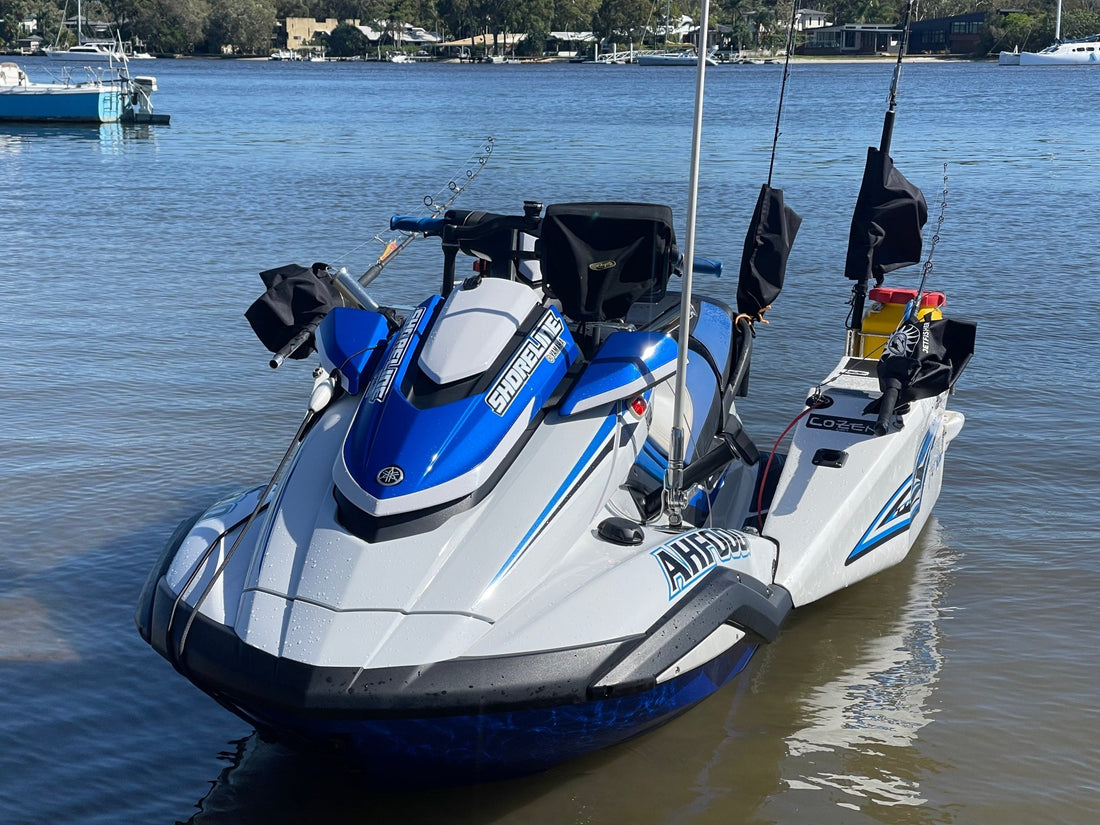
I had expected some sort of emotional reaction to my recent YouTube channel fishing video. Featuring a slightly controversial clickbait title to grab attention, the video showcases the fishing fit-out of my 2019 Yamaha FXHO.
One viewer commented, I assume with sarcasm in mind, “Get a boat!” That got me to re-think my motivations. Why get a PWC and turn it into a serious fishing craft? What would I do if I was designing a new “Fishing PWC” from the ground up?
My Yamaha 2019 Waverunner is equipped with “Tubbies” fishing pods, Garmin Sounder/GPS, GME 25W Marine VHF radio, and a variety of other accessories that I find invaluable for my passion. The design come from my own needs for fishing, some trial and error, and some great advice from some local PWC dealers that understand fishing.
Aside from the obvious advantages of a PWC - towing, launching, storing, fuel economy to mention just a few- a PWC allows you to fish many locations, under different weather conditions, using many different techniques, and with a minimum of fuss. In summer, we troll for larger pelagic species like the Spanish Mackerel, often 1.3M and 20KG or more. In our mild winters, we fish the reefs for snapper, cod, and Mulloway. We also a fish the surf white-water for Tailor (Pomatomus saltatrix), a feat not able to be accomplished on a boat due to very shallow and rough water -and the high chance of being capsized by waves!
The number one limiting factor for any offshore fishing is feeling unsafe. Locally, the deeper waters are quite a distance away, and I can be 20 km or more offshore, and far greater distances from my launch spot. Roundtrips of over 100 Km in the day are not uncommon, so carrying adequate safety kit, and a very reliable PWC, are paramount.
With safety in mind, Fishing PWCs need added stability to stop capsizing in serious swell and surf, fuel economy for long trips, dual batteries for electrical peace of mind, and lots of rod holders and fishing gear storage. Recognising the emerging fishing market, the Seadoo Fishpro was released late in 2019, and is a good solution for the beginner to intermediate users that want to have a “drive-away” package price. I am hopeful the “Fishing PWC” market is also recognised by Yamaha and Kawasaki so they too introduce technologies and features not only necessary for a better fishing experience, but with the safety of the rider in mind. The competition will help drive advances in design and functionality.
Aside from carrying all regulatory safety equipment, my fishing pods, the Tubbies, are a my most serious safety device, and largest investment. These fibreglass pods fit securely to the rails of the ski and greatly extend the storage space, but more importantly, the buoyancy of the ski. They make the ski very stable on rough waters and surf, give me the ability to carry all manner of fishing kit, but more importantly their internal shell has positive buoyancy and will stop the ski from sinking, even if the Waverunner hull is full of water. They give me leg protection against sharks or other toothy critters, and they also keep my rear swim-up platform unobstructed. It happens- there are cases of PWC fishers being rescued after being unable to climb back on an unstable ski, or over a rear mounted cooler.
Handheld VHF radios, commonly only 5 Watts in power, are fine for person-to-person or line of sight. Losing radio comms and visual sight is an unnerving feeling in a remote location. I always carry a Personal Location Beacon (PLB) on my PFD, and on this craft I installed the 25W GME VHF for peace of mind.
Safety aside, my fishing time is limited. I want to have the best chance of bringing some fish home, so maximising the time on the water means having the right kit onboard. That’s why I have invested in other accessories. Rod holders, dual battery systems, navigation lights, and a “tow-tap” are all necessary for the more serious fisho.
What is the future for the “Fishing PWC”? I’d like to see all manufacturers add additional options that target this growing sector. Aside of factory mounting points allowing users to choose their favourite GPS/Sounder units and sizes, the location of the transducer is very important. Jet wash causes air bubbles in the water, decreasing or eliminating the ability for the Sounder to get readings. In-hull mounting of the Transducers in Yamaha’s NanoExcel hull is not ideal for quality readings. Using transducers in-hull or “though-hull” means you can’t use a “Sidescan” feature, nor get accurate water temperature readings. A clever manufacturer might design a place in the hull or ride plate to mount a variety of transducers, allowing the full features of the GPS/Sounder to be realised, yet protecting the transducer from damage.
The second advancement might be “spot-lock”, a feature found of boat “trolling motors”. Using a deployable electric motor to position your craft over a given GPS point, the angler can target a specific reef point or school of fish. The motor drives the boat against the currents caused by wind and tides, and positions the craft exactly where you want it. It is also “stealthy”, keeping noise to a minimum, especially helpful in shallower waters, or locations under fishing pressure where fish seem to have learnt that noise means danger! Some jet ski fishos have mounted existing “boat-size” trolling motor solutions, but they are far from ideal. A solution could be small but powerful electric motors mounted on left and right rear corners of the PWC and powered by an additional battery mounted inside the ski hull.
Manufacturers could also benefit by creating a range of off-the-shelf fishing accessories. Strong rod holders that are easily attached and removed, both watertight and “wet” storage, factory-supplied dual battery kits, and other such items would sell well. You can buy these now from many from local manufacturers, but due to scale of manufacturing, it’s hard to have a complete range available for every model of PWC. The added costs in labour for fitting specialised electrical items is also a limiting factor.
In summary, fishing from a PWC has many advantages over a boat for enthusiasts, yet they have the same needs for maximising the quality of time out on the water. It is a growing and specialised market, with local social media jet ski fishing groups seeing many new members each week. Manufacturers that focus on safety, plus the necessary technical and convenience accessories required for a Fishing PWC, would likely increase unit sales, while introducing more people to enjoy this healthy and rewarding activity.
Watch the video on this topic:

